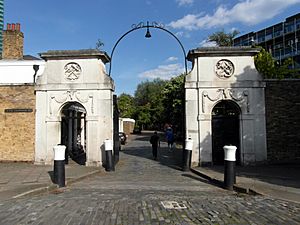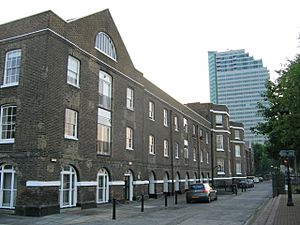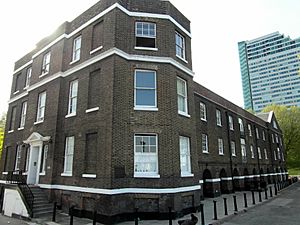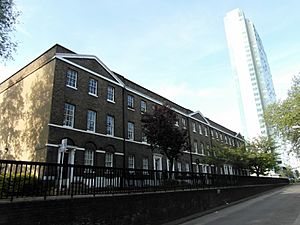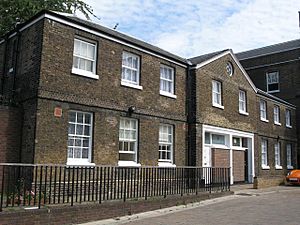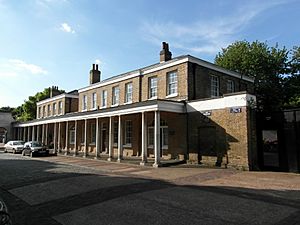HM Victualling Yard, Deptford facts for kids
The HM Victualling Yard, Deptford was a very important place for the Royal Navy in London, England. It was like a giant supermarket and factory all rolled into one, where the Navy got all its food and supplies for its ships and sailors. This yard was located right next to the Deptford Royal Dockyard on the River Thames. For almost 300 years, from the mid-1600s to the early 1960s, this place was busy making sure sailors had enough to eat and wear.
Before it became the main Victualling Yard, it was known as the Red House, Deptford. In 1743, a group called the Victualling Commissioners took over the site. They made it their main base for getting supplies. After being rebuilt in the late 1700s, it grew to be "the largest food-processing operation in Britain, if not in Europe." This means it was a huge place for making and preparing food! After 1858, it was officially called the Royal Victoria Victualling Yard.
Deptford was a great location because it was close to London's food markets. This made it easy to get fresh supplies. The yard didn't just supply ships at Deptford. It also sent food and other items to other important Navy bases like Woolwich, Sheerness, and Chatham. It even sent supplies to other Navy victualling yards around the world. These supplies included things like rum, food, tobacco, clothes, and even medical items.
Contents
Early Days: The Red House
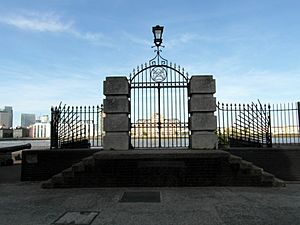
Back in the 1600s, the Navy usually got its supplies from a place near Tower Hill in London. But as the Navy grew, they needed more space. In 1650, during the time of the Commonwealth of England, a slaughterhouse was bought in Deptford to help out.
After the king returned to power in England, a private business owner named Sir Denis Gauden was put in charge of Navy supplies. In 1665, with the Navy getting bigger, Gauden needed more room. He rented a property in Deptford called the Red House. It was a red brick building with a wharf, right next to the main Navy dockyard. The Red House had been damaged by fire before, so it needed to be rebuilt. By 1673, Gauden started moving some of his workers and operations from Tower Hill to Deptford.
The Red House was part of a larger estate called Sayes Court. For the next 70 years, private companies continued to use it to supply the Navy.
Growing Bigger: HM Victualling Yard
In 1742, the Victualling Commissioners decided they wanted to buy 11 acres of the Sayes Court estate, including the Red House. They wanted to make it their main supply hub. The government didn't approve the purchase because it was too expensive. So, instead, they leased the land for £500 a year.
The Commissioners took over the site in 1743. They immediately started building a large new storehouse and fixing other buildings that had been damaged by a fire. They also had big plans to completely rebuild the 11-acre site. Their goal was to have one place where they could buy, make, pack, and send out all the food, drinks, and other supplies the Navy needed. They also planned to have homes and offices for the Commissioners themselves. This big plan was very expensive, costing almost £74,000, but it guided how the yard grew over time.
In the 1740s, they built a mill to make oatmeal and a cooperage to fix barrels. They also built a wall around the whole area. In 1747, their bakehouse in Rotherhithe burned down, so they decided to build a new, bigger one right there in Deptford.
Fires were a big problem back then. In 1748, the new Victualling Office burned down. A spark set some sacks on fire, and the flames spread to stacks of wood and even to two boats on the river that were full of dry food like biscuits. In 1755, the King's Mill was destroyed, and in 1758, the New Storehouse. Even the old Red House, which had been rebuilt in 1640, burned down again in 1761.
It wasn't until the 1780s that the HM Victualling Yard, Deptford, finally got its famous layout and became the huge operation it would be for the next two centuries. A big rebuilding project took place, designed by James Arrow. Behind the riverside storehouses, the yard had many special areas for making and storing different things.
- To the south was the cooperage, where they made and fixed barrels. Most of the yard's products were packed in these barrels.
- To the west was a large meat processing area. It had separate slaughterhouses, cutting houses, and packing houses for beef and pork.
- To the north, near homes for senior officers, was a large brewhouse that made beer for the fleet.
- In the center was a bakery with twelve large ovens, which made bread and ship's biscuits.
In 1785, the Victualling Board closed its old depot at Tower Hill, and Deptford became its main hub.
How the Yard Operated
Some food items were bought locally and then stored at the yard. These included butter, cheese, peas, and fish, as well as ingredients for brewing and baking.
Animals like cattle and pigs arrived either by boat or by walking from places like Smithfield Meat Market in London. The slaughterhouses only operated during the cooler months, from October to April. Fresh meat and bread were given to ships that were in the harbor. But for ships going on long voyages, they were given salted meat and hard biscuits instead of fresh bread. The yard also used animal by-products. For example, hides were used to make leather, and tallow was used to make soap and candles.
What made Deptford special compared to other Navy supply yards (like those in Portsmouth and Plymouth) was that it also made smaller-scale food items. These included mustard, pepper, oatmeal, and chocolate, each made in its own special milling area. There were also separate storehouses for sugar, tea, rice, raisins, wine, and tobacco. All these items were bought in London and stored at Deptford before being sent out to other Navy bases.
During the French Revolutionary and Napoleonic Wars (late 1700s and early 1800s), Deptford's main job was to constantly provide supplies. It either made them or bought them, and then sent them to smaller yards on the south coast and overseas where the Navy's ships were based.
By 1813, the Victualling Yard at Deptford covered almost 20 acres. A 10-horsepower steam engine was installed in the brewhouse. It was used to grind malt and pump beer. A complex system of pipes brought water from the Ravensbourne into different parts of the yard, including the brewhouse, bakehouse, and cooperage. Plugs were installed in case of fires, and cranes on the wharf could deliver water directly to ships. A steam-powered flour mill was added in the 1820s, and biscuit making became partly machine-operated in the 1830s.
Deptford's way of combining manufacturing and storage became a model for new victualling yards built by the Navy in the 1820s. These included the Royal Clarence Victualling Yard in Gosport and the Royal William Victualling Yard in Stonehouse.
People Who Worked There
The main leaders of the yard changed over time. Before 1809, the top officers included:
- Superintendent
- Hoytaker
- Clerk of the Cheque
- Clerk of the Cutting House
- Clerk of the Dry Stores
- Clerk of the Brewhouse
- Master Cooper
- Clerk of the Issues
These officers reported directly to the Victualling Board, which sometimes caused problems with teamwork and responsibility.
To fix this, a group suggested in 1809 that the number of main officers at Deptford be reduced to three:
- Agent Victualler (in charge of everything, like contracts and sending out supplies)
- Clerk of the Cheque (in charge of money)
- Storekeeper (in charge of all items in storage)
Other important officers included:
- Master Cooper
- Master Brewer
- Master Baker
- Master Butcher
- Principal Boatswain
- Principal Stevedore
- Inspector of Works
- Porter
In 1832, the Victualling Board was closed down. The civilian Agent Victualler was replaced by a Navy officer called the Captain Superintendent. Later, in 1869, these roles were removed, and a civilian Storekeeper managed the yard.
Later Years: The Royal Victoria Victualling Yard
Deptford remained the largest Navy supply base in Britain throughout the 1800s. It was renamed the Royal Victoria Victualling Yard in 1858 after Queen Victoria visited. Records from 1868 show that many different skilled workers were employed there. This included 50 coopers, 7 millers, 21 bakers, 6 blacksmiths, 4 sawyers, and 47 other tradesmen. There were also 22 storemen and 67 laborers.
After Deptford's main Royal Dockyard closed in 1869, the Victualling Yard grew even bigger. It expanded into the old Dockyard area. More storehouses were built, and the old mast pond from the Dockyard provided more space for ships to dock. By the end of the 1800s, the Royal Victoria Victualling Yard covered about 35 acres.
Brewing beer stopped in the yard after the Navy ended the beer ration in the 1830s. The old brewhouse then became a clothing store. Rum became the main alcoholic drink for the Royal Navy, and Deptford managed its supply. The rum was left to age in large vats for about two years before being put into casks and sent out. By the late 1800s, Deptford had 32 vats that could hold a total of 230,000 gallons of rum.
Another important drink for sailors was chocolate. Deptford's chocolate mills supplied 1.25 million pounds of chocolate each year. Chocolate production started at Deptford in 1834. A lot of lime juice was also stored there. It was mostly used in hot climates to prevent scurvy, a disease caused by lack of Vitamin C.
After the 1870s, live animals were no longer brought to the yard for slaughter. However, fresh meat was still salted there. By 1900, it was estimated that about 2 million pounds of beef and pork passed through the yard each year. The pork came from Ireland and Denmark, and the beef mostly from America. The meat was salted in 100-pound barrels, and then sealed to be sent out.
The biscuit bakery, with only twelve men, could make 30,000 ship's biscuits a day. It usually operated only in the winter months. Around 450 tons of biscuits were made in Deptford each year in 1900. Grain was bought and stored in a three-story building before being sent to the steam-powered flour mill. Each hexagonal biscuit was stamped with the government's broad arrow symbol and the letter 'D' for Deptford. After baking, the biscuits were dried for three days in special rooms heated to 140 °F (60 °C) using heat from the ovens. It was said that Deptford alone could make enough biscuits to feed the entire Navy! The yard kept enough raw material to make 11 million biscuits in stock.
Deptford always provided more than just the main Navy foods like meat, biscuits, rum, and cocoa. In the 1900s, a wide variety of items were kept there. These included medicines, soap, oil, and acid, as well as large amounts of tea, sugar, jam, salt, raisins, split peas, and preserved milk. Oatmeal, pepper, and mustard continued to be milled at the yard. Port wine was provided in small bottles for church services and also as a "medical comfort" along with things like beef essence and chicken broth. Ships also received tobacco, which was bought in bulk and pressed into barrels using machines.
Food and other items continued to be stored in barrels. Deptford's cooperage made 30,000 barrels a year in the early 1900s. By the 1870s, machines were used for cask-making, but some special casks and other wooden items were still made by hand. The cooperage also supplied "all the wooden paraphernalia of the ship's kitchen." Tinned food had been available to the Navy since 1813, but it was expensive, so its use was limited for a long time.
In the early 1900s, if a Royal Navy ship needed supplies, its officers would order them directly from the closest Victualling Yard. From Deptford, supplies were usually sent downriver in lighters (small boats) to Sheerness, where they could be easily put onto ships. The Royal Victoria Yard also had a railway line, which allowed supplies to be sent to other Navy Victualling Yards or any other port. Supplies for overseas bases were sent as regular freight.
From 1869, the Admiralty Compass Observatory was located in the yard. It was in a small wooden hut in the center of the site. Its leader lived in the Terrace. This observatory was responsible for testing and making sure every compass in the Navy was accurate. It stayed at the yard for almost 50 years.
Closure
By the end of the Second World War (mid-1940s), the yard was less of a storehouse. Its staff mainly checked the quality of supplies, which were now mostly provided by private companies. Some dry and refrigerated food, clothes, and special cold-weather gear were still kept in stock. When the yard finally closed, these items were moved to Portsmouth and Plymouth.
The Royal Victoria Victualling Yard closed in June 1961. Some staff and supplies were moved to the nearby Army Supply Reserve Depot. Most of the old Victualling Yard buildings were torn down. A large housing estate, the Pepys Estate, was built on the site. However, some historic buildings from the 1770s-1780s were saved and turned into homes or community centers. These include the main gate on Grove Street, the 'Colonnade' (which had offices and homes), the terrace of former officers' houses on Longshore, and two old storehouses along the riverbank.
See also


